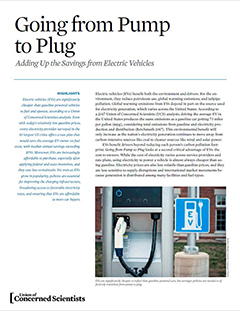What would you do with an extra US$770 a year? Buy a new laptop? Pay off debt? This is how much money many drivers could save by switching from a gasoline-powered car to an electric vehicle.
UCS analyzed the cost of refueling electric and gasoline vehicles in each of the 50 largest cities in the United States. In every city, there is a rate plan that would save the average EV owner on fuel costs, with the median savings over $770 per year.
EVs are becoming more affordable to purchase, especially after federal and state incentives are applied. However, barriers remain. The future of the federal income tax credit for EVs is in doubt and policies are needed to ensure that all drivers have the ability to choose an EV. This includes improving charging infrastructure and ensuring access to cost-competitive electric rates for recharging.
We make recommendations for EV drivers to maximize savings; and for policy-makers, electricity providers, and automakers to advance policy that promotes EV adoption, and broadens access to charging infrastructure.
Findings
- The annual savings range from $440 to over $1,070 per year, depending on the electricity provider, the choice of electricity rate plan, and the local cost of gasoline.
- Many electricity companies offer affordable off-peak, time-of-use plans that benefit EV drivers. EV owners mostly charge their cars parked at home, overnight, which often matches times of lower overall electricity demand. Many utilities offer lower rates during these times. Off-peak, time-of-use rates vary from $.03 per kWh to $0.21 per kWh, resulting in gasoline equivalent costs ranging from $0.25 per gallon to $1.78 per gallon.
- The price of electricity is more stable than oil prices because it can be generated from diverse sources and US electricity markets are regulated. In constant dollars, and when expressed in equivalent gasoline prices, the national average price of electricity as a vehicle fuel has remained around $1 per gallon ($0.88 to $1.17 per gallon) over the last 15 years. Average US gasoline prices between 2002 and 2017 ranged from less than $2.00 to more than $4.50 a gallon.
- Purchase prices of EVs are going down. The cost to produce the battery pack of EVs drives their manufacturing costs, which have been typically higher compared with those for gasoline vehicles. But falling battery costs, and rising EV production are expected to bring the purchase prices of EVs down to approach those of gasoline vehicles.
- EVs can be cheaper to maintain than comparable gasoline vehicles. Battery electric vehicles, like the Chevrolet Bolt EV, do not require oil changes and other engine services while the electric motor and battery systems require little to no scheduled maintenance.
Recommendations for drivers considering an EV
- Evaluate the ability to get electric power where you intend to park an EV.
- Find out about rate options available for charging an EV, especially whether your electric provider offers time-of-use rates.
- Research the availability of state, local, and electricity-provider incentives for buying an EV or EV charging equipment.
Recommendations for policymakers and electricity providers
- Access to lower-cost electricity rate plans are key to making EVs a reliable and affordable alternative to gasoline vehicles.
- Access to reliable and public charging, especially fast-charging stations, are needed for those drivers who cannot charge at home and those who must drive long distances.
- Public policies that improve charging options at apartments and multi-unit dwellings will broaden the base of drivers who can choose an EV.
- Making separate rates for EV and household electricity available could lower the cost for EV charging for more consumers.
- Rate plans, pricing mechanisms, and smart-charging technologies that encourage the coordination of EV charging with the availability of renewable electricity sources will decrease charging costs and further reduce heat-trapping emissions.
Recommendations for policymakers and automakers
- Federal and state purchase incentives are vital to making EVs an affordable and competitive option.
- Incentive programs for lower-income households to adopt EVs will bring the economic benefits from lower fuel costs to communities and demographics that need it the most but currently lack the ability to invest in an EV.
- Public policies that require manufacturers to produce higher volumes of EVs and encourage a greater diversity of electric-drive models and sizes will lower purchase prices for EVs.




